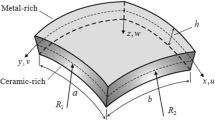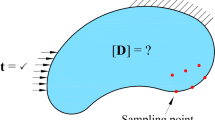Abstract
The elastodynamic behavior of layered media consisting of an arbitrary combination of isotropic and transversely isotropic layers is of great importance for many engineering applications. In this work, some appropriate elastodynamic Green’s functions pertinent to both the displacement and the stress fields are devised so that the problems associated with the n-layer semi-infinite and infinite media with any combinations of transversely isotropic and isotropic layers subjected to surface and buried oblique time-harmonic annular loading can all be treated in a unified manner. The material degeneracy arising due to the scenarios where one or more regions are isotropic is also discussed and treated. The proposed Green’s functions are then utilized to address a number of illustrative examples involving different combinations of transversely isotropic and isotropic layers subjected to such loading conditions as point load, ring as well as full circularly distributed loads, and loading along a circle perimeter including normal, horizontal, and torsional type loads. The robustness of the current formulations is shown through the verification of the available results pertinent to several problems with diverse topologies and loading conditions. Additional examples which have not been addressed in the literature are also treated herein and verified either by using finite element analysis (FEA) or by considering the pertinent analytical limiting cases.










Similar content being viewed by others
References
Boussinesq J (1885) Application des Potentiels À L’étude de L’équilibre et du Mouvement des Solides élastiques. Mémoires de la société des sciences, de l’agriculture et des arts de Lille. Gauthier-Villars, Paris
Love AEH (1927) A treatise on the mathematical theory of elasticity. Cambridge University Press, Cambridge
Lamb H (1904) I. On the propagation of tremors over the surface of an elastic solid. Philos Trans R Soc Lond Ser A 203(359–371):1–42
Chau K-T (2012) Analytic methods in geomechanics. CRC Press, Roca Baton
Pak RYS (1987) Asymmetric wave propagation in an elastic half-space by a method of potentials. J Appl Mech 54(1):121–126
Guzina BB, Pak RYS (1999) Static fundamental solutions for a bi-material full-space. Int J Solids Struct 36(4):493–516
Pak RYS, Guzina BB (2002) Three-dimensional Green’s functions for a multilayered half-space in displacement potentials. J Eng Mech 128(4):449–461
Xu J, Davies TG, Pan E (2007) Efficient and accurate multi-layered elastostatic Green’s functions via the bi-material Green’s function. Eng Anal Boundary Elem 31(8):683–691
Michell J (1900) The stress in an æolotrophic elastic solid with an infinite plane boundary. Proc Lond Math Soc 1(1):247–257
Eubanks RA, Sternberg E (1954) On the axisymmetric problem of elasticity theory for a medium with transverse isotropy. J Rational Mech Anal 3:89–101
Lekhnitskii SG, Brandstatter JJ, Fern P (1963) Theory of elasticity of an anisotropic elastic body. Holden-Day series in mathematical physics. Holden-Day, San Francisco
Hu H-C (1953) On the three-dimensional problems of the theory of elasticity of a transversely isotropic body. Sci Sinica 2(2):145–151
Nowacki W (1954) The stress function in three-dimensional problems concerning an elastic body characterized by transverse isotropy. Relation 1(3):1–8
Wang M, Wang W (1995) Completeness and non uniqueness of general solutions of transversely isotropic elasticity. Int J Solids Struct 32(3–4):501–513
Pan Y-C, Chou T-W (1976) Point force solution for an infinite transversely isotropic solid. J Appl Mech 43(4):608–612
Pan Y-C, Chou T-W (1979) Green’s function solutions for semi-infinite transversely isotropic materials. Int J Eng Sci 17(5):545–551
Ernian P (1989) Static response of a transversely isotropic and layered half-space to general surface loads. Phys Earth Planet Inter 54(3–4):353–363
Rajapakse R, Wang Y (1991) Elastodynamic Green’s functions of orthotropic half plane. J Eng Mech 117(3):588–604
Rajapakse R, Wang Y (1993) Green’s functions for transversely isotropic elastic half space. J Eng Mech 119(9):1724–1746
Wang C (1997) Elastic fields produced by a point source in solids of general anisotropy. J Eng Math 32(1):41–52
Willis JR, Hill R (1973) Self-similar problems in elastodynmics. Philos Trans R Soc Lond Ser A 274(1240):435–491
Pan E, Yuan F (2000) Three-dimensional Green’s functions in anisotropic bimaterials. Int J Solids Struct 37(38):5329–5351
Yang B, Pan E (2002) Three-dimensional Green’s functions in anisotropic trimaterials. Int J Solids Struct 39(8):2235–2255
Tewary VK (2004) Elastostatic Green’s function for advanced materials subject to surface loading. J Eng Math 49(3):289–304
Eskandari-Ghadi M (2005) A complete solution of the wave equations for transversely isotropic media. J Elast 81(1):1–19
Eskandari-Ghadi M, Sture S, Pak RYS, Ardeshir-Behrestaghi A (2009) A tri-material elastodynamic solution for a transversely isotropic full-space. Int J Solids Struct 46(5):1121–1133
Ding H, Chen W, Zhang L (2006) Elasticity of transversely isotropic materials, vol 126. Springer, Cham
Ewing WM (2018) Elastic waves in layered media. Creative Media Partners, LLC, New York
Gerrard CM (1985) Stresses and displacements in layered, cross-anisotropic, elastic systems. Golden Jubilee Int Soc Soil Mech Found Eng 102:1–9
Lamb H (1901) On Boussinesq’s problem. Proc Lond Math Soc 1(1):276–284
Hasegawa H, Lee V-G, Mura T (1992) Green’s functions for axisymmetric problems of dissimilar elastic solids. J Appl Mech 59(2, Part 1):312–320
Author information
Authors and Affiliations
Corresponding author
Additional information
Publisher's Note
Springer Nature remains neutral with regard to jurisdictional claims in published maps and institutional affiliations.
Appendices
Appendix A: Material degeneracy
As it was alluded to, the determination of the unknown constants in Eqs. (26)–(31) require the coefficient matrices \({\mathscr {M}}\)(\(\xi \)) and \({\mathscr {N}}\)(\(\xi \)) which appear, respectively, in Eqs. (32) and (33) be invertible. The requirement is met so as long as all layers I, II, and III are transversely isotropic. But, if any of the layers is made of an isotropic material then \({\mathscr {M}}\)(\(\xi \)) will be non-invertible, as its determinant will be identically equal to zero. It should be noted that in the case of isotropic materials, \(\lambda _{1}\) and \(\lambda _{2}\) in Eq. (19) will become equal and cause Eq. (16) to have a repeated root. More specifically: (1) if layer I is isotropic then the first two columns of \({\mathscr {M}}\)(\(\xi \)) become identically the same; (2) if layer II is isotropic then columns 3 and 5 as well as columns 4 and 6 become identical; and (3) if layer III is isotropic then columns 7 and 9 and also columns 8 and 10 become identical. Thus under any of the above-mentioned conditions \({\mathscr {M}}\)(\(\xi \)) becomes singular. Hence, for isotropic layers, Eqs. (26), (28), (30), (34), and (36) should be modified to prevent singularity in Eq. (34). Assume the proposed medium consists of two finite and one semi-finite isotropic layers, then due to the equivalency of \(\lambda _{1}^\Sigma \) and \(\lambda _{2}^\Sigma \; (\Sigma =I,II,III)\), mentioned equations are changed as follows:
One of the applicabilities of the proposed formulation is that a combination of layers with isotropic and transversely isotropic materials can be modeled. For example, if only layer II (the middle layer in the medium made of two finite and one semi-finite layers) is isotropic, then Eq. (A2) instead of Eq. (28), and all of the components of columns 5 and 6 in the medium of Eq. (A4) with the parameters of Eq. (A5) instead of components of columns 5 and 6 in the medium of Eq. (34) with the parameters of Eq. (36) should be utilized.
Appendix B: Green’s function associated with axisymmetric loadings
In general, axial loading in z-direction is an axisymmetric loading, while the plane loading is not axisymmetric (Fig. 2a and b). As a special case, one can define axisymmetric loading cases in the radial and rotational directions in the \(x-y\) plane. In this case, the value of \(\theta -\theta _0\) for P and Q in Eq. (41) should be zero and \(\pi /2\) for axisymmetric radial and rotational plane loadings, respectively (Fig. 2d and e). The displacement Green’s function of axisymmetric loading conditions (Fig. 2b, d, and e) are as follows:
in which, \({\hat{F}}_m^m={\tilde{F}}_m^m \mathrm{{e}}^{\text {i}m\theta _0}\) and \({\hat{\chi }}_m^m={\tilde{\chi }}_m^m \mathrm{{e}}^{\text {i}m\theta _0}\). In fact, \(G_{ij}(r,\theta ,z,t)\) represents the displacement in the i-direction at point (\(r, \theta ,z\)) and time t due to a uniform annular loading with inner radius “a” and outer radius “A” in the j-direction at \(z=z_0\) plane and time \(t_0\). From Eqs. (41)–(43), it can be shown that \(G_{r \theta }=G_{\theta r}\). It should be noted that \({\hat{F}}_{0}^{0}\) and \({\hat{\chi }}_{0}^{0}\) in Eq. (B1) are obtained from Eqs. (26)–(38) for each loading direction. Moreover, for different radial, rotational, and axial loading directions, the parameters \(X_m, Y_m,\) and \(Z_m\) in Eq. (38) are as follows:
Radial Loading:
Rotational Loading:
Axial Loading:
In the Eqs. (B2) and (B3), \((x)_k\) represents the Pochhammer symbol which can be expressed as:
Rights and permissions
Springer Nature or its licensor holds exclusive rights to this article under a publishing agreement with the author(s) or other rightsholder(s); author self-archiving of the accepted manuscript version of this article is solely governed by the terms of such publishing agreement and applicable law.
About this article
Cite this article
Soleimani, K., Shodja, H.M. & Rashidinejad, E. Elastodynamic Green’s functions of transversely isotropic n-layer half- and full-spaces subjected to a surface or buried time-harmonic annular loading and associated material degeneracy. J Eng Math 136, 3 (2022). https://doi.org/10.1007/s10665-022-10237-4
Received:
Accepted:
Published:
DOI: https://doi.org/10.1007/s10665-022-10237-4




